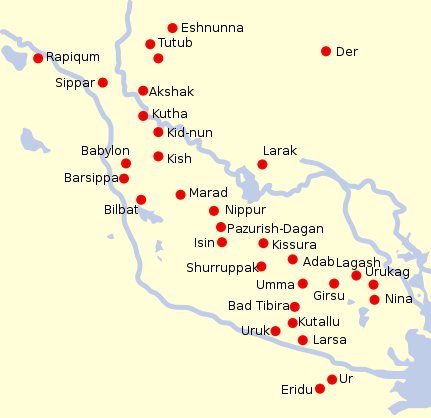Once again. There were 32 city states in Mesopotamia - the land between the rivers - although only 32 - 3 - 6 = 23 of them were located between the quickly running Tigris (Arrow) up in the northeast and the peacefully undulating black river Euphrat (Sweet Water) down in the southwest:
... and then, with stunning abruptness, at a crucial date that can be almost precisely fixed at 3200 BC (in the period of the archaeological stratum known as Uruk B), there appears in this little Sumerian mud garden - as though the flowers of its tiny cities were suddenly bursting into bloom - the whole cultural syndrome that has since constituted the germinal unit of all the high civilization of the world ... Eridu had the lowest position among the city states and in the sky the corresponding station was illustrated as a place where the sweet irrigating water had been completely run out:
... At the end of the Golden Age (Krita Yuga) a class of Asura who had fought against the 'gods' hid themselves in the ocean where the gods could not reach them, and planned to overthrow the government. So the gods implored Agastya (Canopus, alpha Carinae = Eridu) for help. The great Rishi did as he was bidden, drank up the water of the ocean, and thus laid bare the enemies, who were then slain by the gods. But now, there was no ocean anymore! Implored by the gods to fill the sea again, the Holy One replied: 'That water in sooth hath been digested by me. Some other expedient, therefore, must be thought of by you, if ye desire to make endeavour to fill the ocean ...
However, at the end of the previous creation there could have been a Deluge which swept away all the old: ... When it was evident that the years lay ready to burst into life, everyone took hold of them, so that once more would start forth - once again - another (period of) fifty-two years. Then (the two cycles) might proceed to reach one hundred and four [104] years. It was called 'One Age' when twice they had made the round, when twice the times of binding the years had come together. Behold what was done when the years were bound - when was reached the time when they were to draw the new fire, when now its count was accomplished. First they put out fires everywhere in the country round. And the statues, hewn in either wood or stone, kept in each man's home and regarded as gods, were all cast into the water. Also (were) these (cast away) - the pestles and the (three) hearth stones (upon which the cooking pots rested); and everywhere there was much sweeping - there was sweeping very clear. Rubbish was thrown out; none lay in any of the houses ... In the year 3149 B.C. the Bucket Rope (Kerb, τ Pegasi) had been close to the Full Moon in the night of 29 JUNE, with Sirius at the Sun in the following day:
In the list of 23 stars on the Central Path of Anu (possibly corresponding to the number of cities between Tigris and Euphrat) there were 7 arriving before the Pleiades:
The Field - where Ea had been sitting down - stretched to Algenib Pegasi in the day after the 2nd Spout (at Sirrah, α Andromedae):
Seven Macaw had been defeated in May 28 in the year 3149 B.C. This year could have been connected with the position of nakshatra Sirius because 3149 B.C. was 70 right ascension days before the time of rongorongo and December 30 (364) - when Sirius always would be close to the Full Moon - was 70 days earlier than March 10 (69). Therefore Seven Macaw could have been defeated in the preceding day (in 29 DECEMBER) at heliacal Kerb (the Bucket Rope for lifting up fresh water) - for at the time of rongorongo this star inside the Pegasus Square had been pushed ahead with 70 days due to the precession and was now rising with the Sun in March 9 (68).
May 28 was day 68 after 0h and March 9 was day 68 counted from January 1. May 28 (148) - 68 (March 9) = 80 (March 21 = 0h).
... This pot depicts one of the Hero Twins (One-Ahaw in the Classic texts and One-Hunaphu in the K'iche' Popol Vuh) and a great bird who is trying to land in a huge ceiba tree heavy with fruit. This mythical bird is Itzam-Yeh, Classic prototype of Wuqub-Kaqix, 'Seven-Macaw', of Popol Vuh fame. In that story, in the time before the sky was lifted up to make room for the light, the vainglorious Seven-Macaw imagined himself to be the sun. Offended by his pride, the Hero Twins humbled him by breaking his beautiful shining tooth with a pellet from their blowgun. This pot shows One-Ahaw aiming at the bird as he swoops down to land in his tree. As Itzam-Yeh lands on his perch, the text tells us he is 'entering or becoming the sky'. This particular 'sky-entering' is not the one mentioned in the Palenque text. It is the final event that occurred in the previous creation before the universe was remade. Before the sky could be raised and the real sun revealed in all its splendor, the Hero Twins had to put the false sun, Itzam-Yeh, in his place. If the date on this pot corresponds to that pre-Columbian event, as we believe it does, then Itzam-Yeh was defeated on 12.18.4.5.0.1 Ahaw 3 K'ank'in (May 28, 3149 B.C.). After the new universe was finally brought into existence, First Father also entered the sky by landing in the tree, just as Itzam-Yeh did ... At the time of rongorongo it was Aldebaran which rose with the Sun in day 148 (May 28).
|
|||||||||||||||||||||||||||||||||||||||||||||||||||||||||||||||||||||||||||||||||||||||||||||||||||||||||||||||||||||||||||||||||||||||||||||||||||||||||||||||||||||||||||||||||||||||||||||||||||||||||||||||||||||||||||||||||||||||||||||||||||||||||||||||



















